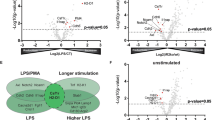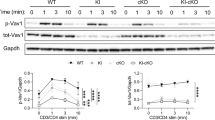Abstract
The Vav family of Rho-guanine nucleotide exchange factors (GEFs) is thought to control a diverse array of signaling pathways emanating from antigen receptors in lymphocytes, although the exact mechanism by which Vav exerts its function is only beginning to emerge. Vav proteins are modular and contain the Dbl-homology domain, typical of all known Rho-GEFs, in addition to several other structural domains characteristic of proteins involved in signal transduction. Recently, our laboratory generated mice congenitally lacking all three Vav isoforms, providing genetic evidence that the Vav family is critical and nonredundant in T-and B-lymphocyte development and function and is essential in the formation of the adaptive immune system. These experimental also demonstrated that Vav proteins are indispensable for both T-cell receptor—and B-cell receptr-induced Ca++ fluxes. However, detailed analyses of Vav-deficient mice revealed unexpected complexity of Vav involvement in cellular activation. Notably, we observed lineage-specific Vav regulation of mitogen-activated protein kinase signaling, in which Vav was required in T-cell, but not in B-cells. Moreover, the three Vav proteins appear to function specifically in distinct signaling pathways emanating from activating receptors of natural killer cells that trigger natural cytotoxicity.
Similar content being viewed by others
References
Bassing CH, Swat W, Alt FW: The mechanism and regulation of chromosomal V(D)J recobination. Cell 2002;109:S45-S55.
Borowski C, et al.: On the brink of becoming a T cell. Curr Opin Immunol 2002;14:200–206.
Swat W, et al.: Activated Ras signals differentiation and expansion of CD4+8+ thymocytes. Proc Natl Acad Sci USA 1996;93:4683–4687.
Crompton T, Gilmour KC, Owen MJ: The MAP kinase pathway controls differentiation from double-negative to double-positive thymocyte. Cell 1996;86:243–251
Gartner F, et al.: Immature thymocytes employ distinct signaling pathways for allelic exclusion versus differentiation and expansion. Immunity 1999;10:537–546.
Iritani BM, et al.: Distinct signals mediate maturation and allelic exclusion in lymphocyte progenitors. Immunity 1999;10:713–722.
Aifantis I, et al: Constitutive pre-TCR signaling promotes differentiation through Ca2+ mobilization and activation of NF-kappaB and NFAT. Nat Immunol 2001;2:403–409.
Iritani BM, et al.: Control of B cell development by Ras-mediated activation of Raf. EMBO J 1997;16:7019–7031
Shaw AC, et al.: Induction of Ig light chain gene rearrangement in heavy chain-deficient B cells by activated Ras. Proc Natl Acad Sci USA 1999;96:2239–2243.
Shaw AC, et al.: Activated Ras signals developmental progression of recombinase-activating gene (RAG)—deficient pro-B lympocytes. J Exp Med 1999;189:123–129.
Kane LP, Lin J, Weiss A: Signal transduction by the TCR for antigen. Curr Opin Immunol 2000;12:242–249.
Acuto O, Cantrell D: T cell activation and the cytoskeletion. Annu Rev Immunol 2000;18:165–184.
DeFranco AL: B-cell activation 2000. Immunol Rev 2000;176:5–9.
Gauld SB, Dal Porto JM, Cambier JC: B cell antigen receptor signaling: roles in cell development and disease. Science 2000;296:1641, 1642.
Samelson LE: Signal transduction mediated by the T cell antigen receptor: the role of adapter proteins. Annu Rev Immunol 2002;20:371–394.
Koretzky GA, Myung PS: Positive and negative regulation of T-cell activation by adaptor proteins. Nat Rev Immunol 2001;1:95–107.
Bustelo XR: Vav proteins, adaptors and cell signaling. Oncogene 2001;20:6372–6381.
Turner M, Billadeau DD: VAV proteins as signal integrators for multi-subunit immune-recognition receptors. Nat Rev Immunol 2002;2:476–486.
Tomlinson MG, Lin J, Weiss A: Lymphocytes with a complex: adapter proteins in antigen receptor signaling. Immunol Today 2000;21:584–591.
Miletic AV, et al.: Cytoskeletal remodeling in lymphocyte activation. Curr Opin Immunol 2003;15:261–268.
Pizzo P, Viola A: Lymphocyte lipid rafts: structure and function. Curr Opin Immunol 2003;15:255–260.
Zhang W, et al.: Functional analysis of LAT in TCR-mediated signaling pathways using a LAT-deficient Jurkat cell line. Int Immunol 1999;11:943–950.
Bromley SK, et al.: The immunological synapse. Annu Rev Immunol 2001;19:375–396.
Dustin ML, Cooper JA: The immunological synapse and the actin cytoskeleton: molecular hardware for T cell signaling. Nat Immunol 2000;1:23–29.
Grakoui A, et al.: The immunological synapse: a molecular machine controlling T cell activation. Science 1999;285:221–227.
Monks CR, et al: Three-dimensional segregation of supramolecular activation clusters in T cells. Nature 1998;395:82–86.
Lee KH, et al: T cell receptor signaling procedes immunological synapse formation. Science 2002;295:1539–1542.
Fujikawa K, et al: Vav1/2/3-null mice define an essential role for Vav family proteins in lymphocyte development and activation but a differential requirement in MAPK signaling in T and B cells. J Exp Med 2003;198:1595–1608.
Etienne-Manneville S, Hall A: Rho GTPases in cell biology. Nature 2002;420:629–635.
Bustelo XR, Ledbetter JA, Barbacid M: Product of vav proto-oncogene defines a new class of tyrosine protein kinase substrates. Nature 1992;356:68–71.
Margolis B, et al: Tyrosine phosphorylation of vav proto-oncogene product containing SH2 domain and transcription factor motifs. Nature 1992;356:71–74.
Movilla N, Bustelo XR: Biological and regulatory properties of Vav-3, a new member of the Vav family of oncoproteins. Mol Cell Biol 1999;19:7870–7885.
Moores SL, et al: Vav family proteins couple to diverse cell surface receptors. Mol Cell Biol 2000;20:6364–6373.
Fujikawa K, et al: Vav3 is regulated during the cell cycle and effects cell division. Proc Natl Acad Sci USA 2002;99:4313–4318.
Aghazadeh B, et al: Structural basis for relief of autoin-hibition of the Dbl homology domain of proto-oncogene Vav by tyrosine phosphorylation. Cell 2000;102:625–633.
Kuhne MR, Ku G, Weiss A. A guanine nucleotide exchange factor-independent function of Vav 1 in transcriptional activation. J Biol Chem 2000;275:2185–2190.
Han J, et al: Role of substrates and products of PI 3-kinase in regulating activation of Rac-related guanosine triphosphatases by Vav. Science 1998;279:558–560.
Han J, et al: Lck regulates Vav activation of members of the Rho family of GTPases. Mol Cell Biol 1997;17:1346–1353.
Zhang R, et al: Defective signalling through the T-and B-cell antigen receptors in lymphoid cells lacking the vav proto-oncogene. Nature 1995;374:470–473.
Tarakhovsky A, et al: Defective antigen receptor-mediated proliferation of B and T cells in the absence of Vav. Nature 1995;374:467–470.
Fischer KD, et al: Defective T-cell receptor signalling and positive selection of Vav- deficient CD4 CD8+ thymocytes. Nature 1995;374:474–477.
Swat W, et al: Essential role for Vav1 in activation, but not development, of gammadelta T cells. Int Immunol 2003;15:215–221.
Holsinger LJ, et al: Defects in actin-cap formation in Vav-deficient mice implicate an actin requirement for lymphocyte signal transduction. Curr Biol 1998;8:563–572.
Doody GM, et al: Signal transduction through Vav-2 participates in humoral immune responses and B cell maturation. Nat Immunol 2001;2:542–547.
Tedford K, et al: Compensation between Vav-1 and Vav-2 in B cell development and antigen receptor signaling. Nat Immunol 2001;2:548–555.
Inabe K, et al: Vav 3 modulates B cell receptor responses by regulating phosphoinositide 3-kinase activation. J Exp Med 2002;195:189–200.
Reynolds LF, et al: Vav1 transduces T cell receptor signals to the activation of the Ras/ERK pathway via LAT, Sos, and RasGRP1. J Biol Chem 2004;279:18,239–18,246.
Reynolds LF, et al: Vav1 transduces T cell receptor signals to the activation of phospholipase C-gammal via phosphoinositide 3-kinase-dependent and-independent pathways. J Exp Med 2002;195:1103–1114.
Dower NA, et al: RasGRP is essential for mouse thymocyte differentiation and TCR signaling. Nat Immunol 2000;1:317–321.
Gong Q, et al: Disruption of T cell signaling networks and development by Grb2 haploid insufficiency. Nat Immunol 2001;2:29–36.
Raulet DH: Roles of the NKG2D immunoreceptor and its ligands. Nat Rev Immunol 2003;3:781–790.
Cerwenka A, Lanier LL: Natural killer cells, viruses and cancer. Nat Rev Immunol 2001;1:41–49.
Perussia B: Signaling for cytotoxicity. Nat Immunol 2000;1:372–374.
Cella M, et al: Differential requirements for Vav proteins in DAP10- and ITAM-mediated NK cell cytotoxicity. J Exp Med 2004;200:817–823.
Gakidis MA, et al: Vav GEFs are required for beta2 integrin-dependent functions of neutrophils. J Cell Biol 2004;166:273–282.
Author information
Authors and Affiliations
Rights and permissions
About this article
Cite this article
Swat, W., Fujikawa, K. The vav family. Immunol Res 32, 259–265 (2005). https://doi.org/10.1385/IR:32:1-3:259
Issue Date:
DOI: https://doi.org/10.1385/IR:32:1-3:259




